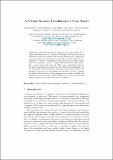Files in this item
A virtual museum installation for virtual time travel
Item metadata
| dc.contributor.author | Fabola, Adeola Ezekiel | |
| dc.contributor.author | Kennedy, Sarah Elizabeth | |
| dc.contributor.author | Miller, Alan Henry David | |
| dc.contributor.author | Oliver, Iain Angus | |
| dc.contributor.author | McCaffery, John Philip | |
| dc.contributor.author | Cassidy, Catherine Anne | |
| dc.contributor.author | Clemens, Jo | |
| dc.contributor.author | Vermehren, Anna | |
| dc.contributor.editor | Beck, Dennis | |
| dc.contributor.editor | Allison, Colin | |
| dc.contributor.editor | Morgado, Leonel | |
| dc.contributor.editor | Pirker, Johanna | |
| dc.contributor.editor | Khosmood, Foaad | |
| dc.contributor.editor | Richter, Jonathon | |
| dc.contributor.editor | Gütl, Christian | |
| dc.date.accessioned | 2018-01-26T15:30:11Z | |
| dc.date.available | 2018-01-26T15:30:11Z | |
| dc.date.issued | 2017-06-07 | |
| dc.identifier | 252051242 | |
| dc.identifier | 2a17a5b8-2462-4946-9064-53010d9843fe | |
| dc.identifier | 85020858733 | |
| dc.identifier.citation | Fabola , A E , Kennedy , S E , Miller , A H D , Oliver , I A , McCaffery , J P , Cassidy , C A , Clemens , J & Vermehren , A 2017 , A virtual museum installation for virtual time travel . in D Beck , C Allison , L Morgado , J Pirker , F Khosmood , J Richter & C Gütl (eds) , Immersive Learning Research Network : Third International Conference, iLRN 2017, Coimbra, Portugal, June 26–29, 2017. Proceedings . Communications in Computer and Information Science (CCIS) , vol. 725 , Springer , Cham , pp. 255-270 , Third International Conference of the Immersive Learning Network , Coimbra , Portugal , 26/06/17 . https://doi.org/10.1007/978-3-319-60633-0_21 | en |
| dc.identifier.citation | conference | en |
| dc.identifier.isbn | 9783319606323 | |
| dc.identifier.isbn | 9783319606330 | |
| dc.identifier.issn | 1865-0929 | |
| dc.identifier.other | ORCID: /0000-0001-9118-4594/work/126553977 | |
| dc.identifier.other | ORCID: /0000-0003-1209-9063/work/40546669 | |
| dc.identifier.uri | https://hdl.handle.net/10023/12619 | |
| dc.description.abstract | This work discusses the methodology for the design, development and deployment of a virtual 19th-century Fish Curing Yard as an immersive museum installation. The museum building now occupies the same space where the curing yard was over 100 years prior, hence the deployment of a virtual reconstruction of the curing yard in a game engine enables the museum visitors to explore the virtual world from equivalent vantage points in the real world. The project methodology achieves the goal of maximising user experience for visitors while minimising cost for the museum, and focus group evaluations of the system revealed the success of the interaction-free design with snackable content. A major implication of the ndings is that museums can provide compelling and informative experiences that enable visitors to travel back in time with minimal interaction and relatively low cost systems. | |
| dc.format.extent | 14 | |
| dc.format.extent | 1438566 | |
| dc.language.iso | eng | |
| dc.publisher | Springer | |
| dc.relation.ispartof | Immersive Learning Research Network | en |
| dc.relation.ispartofseries | Communications in Computer and Information Science (CCIS) | en |
| dc.subject | Virtual reality | en |
| dc.subject | Virtual museum | en |
| dc.subject | Immersion | en |
| dc.subject | 3D reconstruction | en |
| dc.subject | AM Museums (General). Collectors and collecting (General) | en |
| dc.subject | QA75 Electronic computers. Computer science | en |
| dc.subject | 3rd-DAS | en |
| dc.subject | MCP | en |
| dc.subject.lcc | AM | en |
| dc.subject.lcc | QA75 | en |
| dc.title | A virtual museum installation for virtual time travel | en |
| dc.type | Conference item | en |
| dc.contributor.institution | University of St Andrews. School of Computer Science | en |
| dc.contributor.institution | University of St Andrews. Centre for Ancient Environmental Studies | en |
| dc.identifier.doi | https://doi.org/10.1007/978-3-319-60633-0_21 |
This item appears in the following Collection(s)
Items in the St Andrews Research Repository are protected by copyright, with all rights reserved, unless otherwise indicated.

